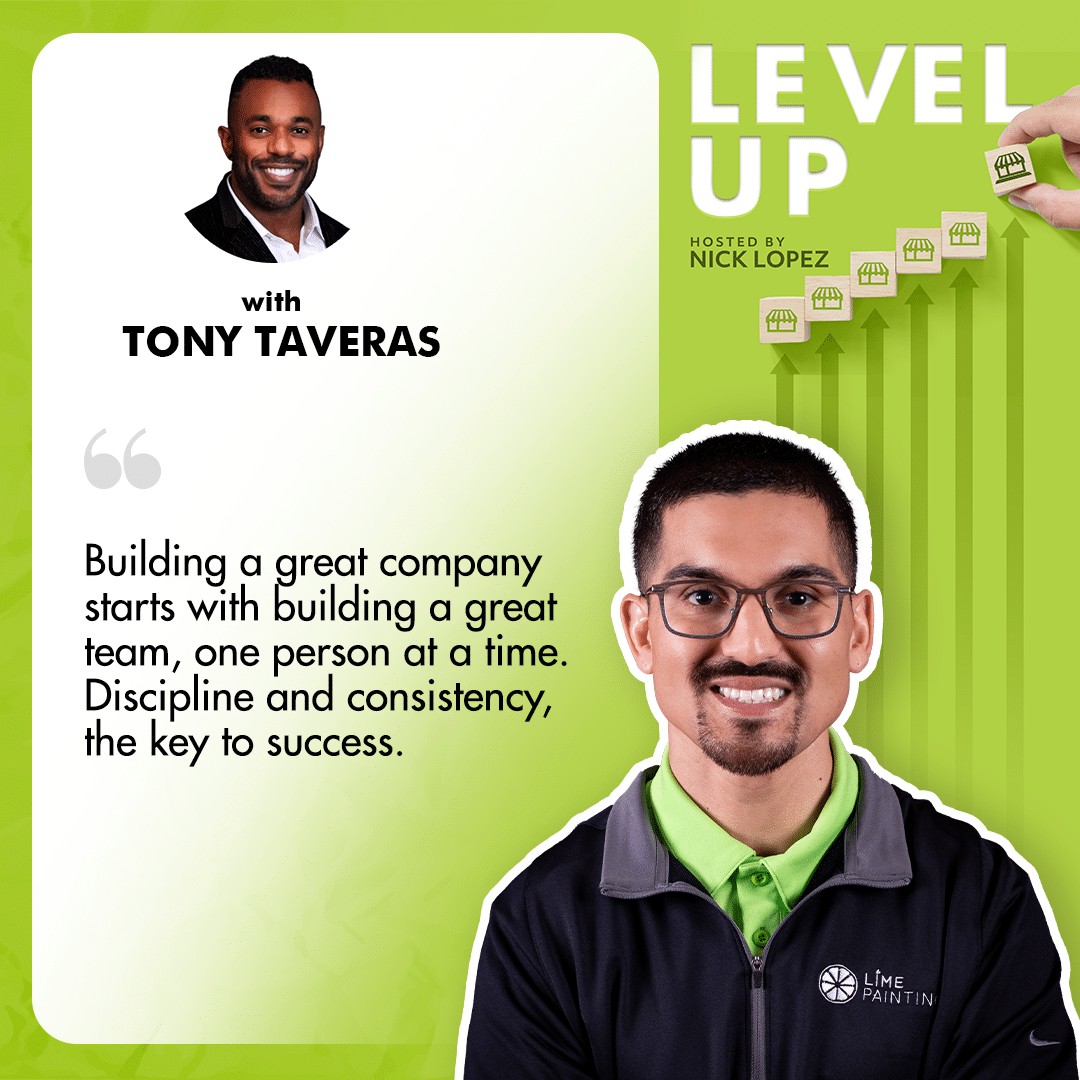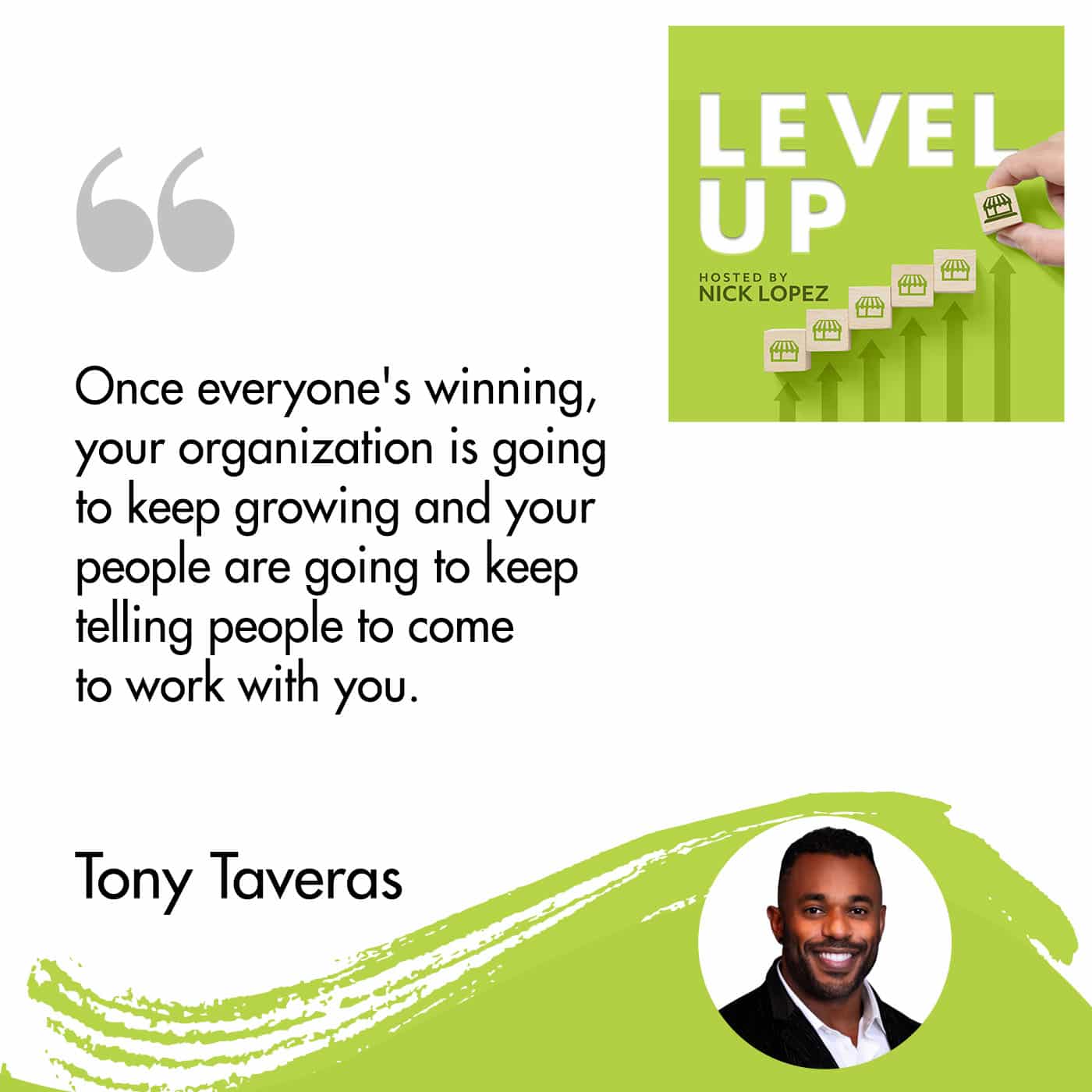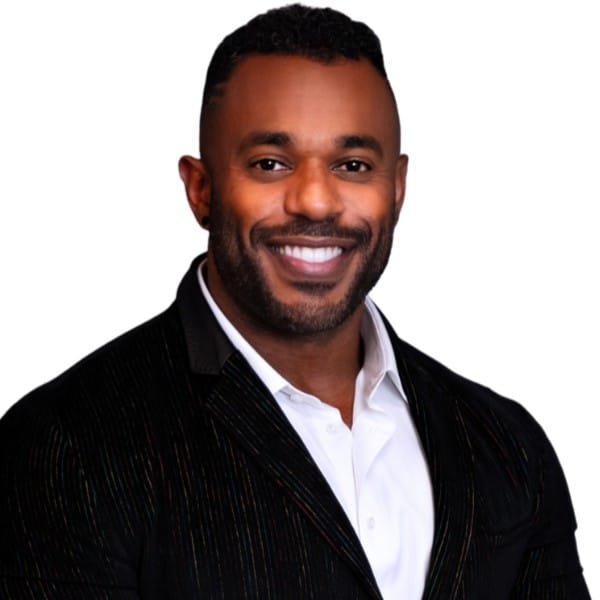
Tony Taveras and Nick Lopez sat down for an exclusive episode to discuss the incredible journey of Linear Roofing. What started as a small business has now grown into a million-dollar insurance restoration organization. But what is their secret to success? According to Tony, the answer is simple: build your company one person at a time. By doing the right thing and establishing a strong company culture, Linear Roofing has created an independent contractor model that invests in its people. The key is to have a team that can get the job done while embodying the company’s values. Tony also discussed what sets high-performance sales representatives apart from the average ones. He explained that it’s all about pursuing your daily goals, working hard, and not settling for anything less than the best results. But building a great company isn’t just about working hard. It’s about creating a culture that rewards, showcases, and invests in the team. This creates good character and a solid team that consistently delivers amazing results. Through their hard work and dedication, Tony and the team at Linear Roofing have proven that with the right mindset, anything is possible.
—
Our guest goes without exception and is most certainly a high performer. He started his career on the fast track to the NFL but was sidelined due to a serious injury. Thankfully, his father prioritized academics. He would then go on to establish himself as a high-performance sales individual in the marketplace. He does professional bodybuilding, competes in that space, and is the Executive Vice President of Sales for an extremely fast-growing roofing company called Linear Roofing. Tony Taveras, welcome to the show.
Thank you for having me. It’s great to be on here.
Thanks for making the time. I’m excited to dive in, learn from you, and allow our audience to get some tips and tricks, and most certainly, level up. Let’s get started with your background. I shared a little bit here in the intro. If you wouldn’t mind starting with your journey from LA Fitness to Linear Roofing. Tell us a little bit about Linear Roofing.
What a crazy journey it’s been. I do feel like one day, there’s going to be a documentary on this thing. That’s how crazy this story is. I still feel like we’re in the baby fetus stage. I’ve always said this as I’ve moved up in my sales career. Every stage that I get to, it’s like we’re warming up. We don’t want to get comfortable. We’re not even there yet. Too many people, they level up and get comfortable and stagnant. That’s not what we’re looking to do here at Linear Roofing.
My dream was to go to the NFL. I was a top athlete out of my high school. My high school was in a little town in Texas called Groesbeck. I grew up in a town called Groesbeck, Texas. Our mascot was a goat. That’s why I got nicknamed The GOAT from twelve years old. Many people see my Instagram, @TonyGoat_Taveras, and they’re thinking this is some cocky dude. It wasn’t that. I was named that from twelve years old because I was a Groesbeck goat, believe it or not. My dad told me what GOAT meant, which meant Greatest Of All Time. Since then, I just ran with it. Anything that I touched, I wanted to be the best at it.

I was a top athlete out of high school. I was all-state. I was big in academics and got recruited by Princeton and Harvard. I took visits to Princeton and Harvard, and my dad wanted me to go there. For me, I just wanted to play ball. I ended up choosing to play ball in North Texas right in my backyard. It was two hours away from Groesbeck.
In my sophomore year, I had a bad injury. I got cut on a kickoff. My hip and pelvis came out of alignment. I was having sharp pains up my pelvis, and I just decided to walk away from the game. I was in line to go to the NFL. That dream was shattered. After that dream was shattered, I ended up stumbling upon LA Fitness, so ended up getting recruited.
I was working out at a gym one day, and a guy that was running the newest location in Denton, Texas ended up pulling me in for an interview. I sat down with the Vice President at the time. I didn’t know this was going to happen, but that VP at the time, the regional, his name was Kirt Linington. He gave me my first real sales position. Fast forward, many years later, I’m still with him, believe it or not. That’s the CEO of Linear Roofing. We’ve been together now for several years.
I became one of the top PT sales trainers in the country for LA Fitness. I started at 21 years old. I got good at selling personal training. I had a theater background. That acting, over-the-top, excitement, and energy coupled with my athletic background and understanding of personal training, took off. I got great at selling. I became a Vice President for LA Fitness at 24 years old. I became regional at 26. I was on the acquisition team for LA Fitness. When we would go acquire other health club chains, I was the guy going into these acquisitions and training all the personnel on how to do what we did in selling PT our way and integrating them into our systems, processes, and scripts.
At about 27 or 26 years old, I was regional. I was running the entire West Coast of Florida from Tampa down to Naples, all the $10 million facilities. You would think I was good. At that point, I was running all the beach clubs. I was going to the beach on the weekends. I was making over $200,000 a year. I was in my twenties. People were like, “Isn’t this what you wanted?” At that point, I felt like I was late to the dance to become a partner with that organization. We had gotten so big. We were a billion-dollar organization at the time. I was this young gun coming up who felt I was a little too late to the dance to earn the equity that I wanted to earn.
I ended up visiting Kirt Linington, who was still in LA Fitness with me at the time for his birthday. He was an executive with LA Fitness, and he showed me the model of Linear Roofing. He started Linear Roofing on the side while we were in LA Fitness. I looked at the model, and I said, “You got something here. This could be something special.”
How I knew that, my parents were running a business called ILSA, Insurance Licensing Services of America. They owned that and ran that for over twenty years. Their clients were Chubb and AIG, some of the biggest insurance carriers in the world. I saw that there was so much potential if a company could come in in roofing in the insurance restoration space and do it right, that they could scale and become something great. I decided to resign from my role and take a shot at roofing.
Fast forward many years later, which is fast in our space, we’ve become the authority figure in roofing. We transacted with private equity months ago, which was the largest deal in our industry in the insurance restoration space. We’re taking on another roofing company every 2 to 3 months into our platform, and I own stock on that platform. The goal is to eventually transact again within the next 12 months, which could be about $1 billion. We’re doing it right. I got featured on an HGTV show, and now we are scaling and growing at a rapid pace. That’s where we’re at.
You can see that Tony is an individual that doesn’t settle for mediocrity, breaking ceilings, getting in that uncomfortable zone to get better, and ultimately, hitting the next level. You mentioned a lot there, but that was what stood out to me, is you’re a high performer. That was why I was wanting to have you on the show and share your mind around performance and specifically, sales and home service. There’s plenty to glean.
I’m curious, as you were wrapping up there, you talked about these strategies for growth with linear roofing. What is the model? Is it a licensing model? Is it a franchise model? Is it corporate? It seems like you’re acquiring smaller roofing companies when they come into the fold. What’s that relationship? What is your expansion strategy?
We started it where I was the guy on the ground learning how to do the process to the best of my ability. It’s one person at a time. I got in the field. I learned how to knock on doors at the highest level in this industry. I figured out, “If I was a homeowner, how would I like to be coached on the process?” I didn’t have any bad habits. I didn’t know anything about roofing. I didn’t even know what a shingle was, guys.
To walk into a space and not know anything was my advantage because I knew sales and customer service. I knew how to create value. I walked in and I said, “How do we make this the best process we could possibly make this?” A lot of people could put on a roof, but it’s about giving them the best experience that they’ve ever had with a GC in their entire life. That’s going to lead to more business and referrals. That’s how it started.
I started recruiting some of the top sales personnel that I ever worked with in the fitness industry one by one, top VPs, top directors, and top general managers who also didn’t know roofing. It’s the number one company in this space, and we built it around guys who didn’t even know anything about roofing. They were great at sales and customer service.
We brought in true professionals. We taught them how we did it with no bad habits, and then we showcased our people. We made it about our people. We made it about our people winning. We got them winning at such a high level that it changed their lives and their families’ lives. We created this social media presence where it truly became a culture that you wanted to work for. It’s not like we had to go out and create all these Indeed ads and all these Monster ads and do all these job fairs. We built this thing one person at a time by getting them up to speed and getting them winning and taking care of our people.
A lot of roofing companies are known for bringing people in, giving them a script, and telling them to go knock on doors. They don’t train them. From a fitness sales background, I was used to an LA Fitness running boot camps every single week and drilling the scripts. We got to the point where we did the same thing in roofing. We got people up to speed so well. They started making great money. They started telling people what this thing was about. Lo and behold, years later, now, we’re up to about 200 project managers in just our company, not in all the other companies that are in line with the platform.
That’s our model. It’s an independent contractor model, to answer that question. It’s not like in LA Fitness. We had employees. In this business, you have to get people to do the job and be great at it by choice. You can’t force them to do anything as an independent contractor. You got to create a culture that influences thinking rather than trying to control the results and force people to do anything because you could catch yourself in hot water if you do in an independent contractor situation and business.
It’s growing through a corporate model and leveraging independent contractors. What a beautiful way to expand. I’m looking forward to getting into a little bit more of the weeds on your thoughts around scaling a sales team and some of the processes there. Before we do, I want to get your take on what you think separates high-performing sales reps from average and low performers. What are some common denominators that you see that create that separation?
I sold at the highest level for about twelve years and then I got to the point where then I’m training leaders to teach other people how to sell. For me, a lot of people who stay in that mediocre-type lane, who never bust out and become great performers, make it all about the money. If you make it all about the money, when you get enough money, you start slowing down.
In LA Fitness, we had a quota every day. In my club, I had an invoice goal. I had to sell at one point $10,000 of personal training every day in my store. It got ingrained in me as a salesperson. I can’t blank one day. I was all about sets, shows, and closes in that business. If I didn’t have appointments walking in and I blank, I’m now $20,000 in the hole.
You have the ability to understand every day is its own day, every month is its own month, and it resets. Once you get done with a month, you can’t rest and say, “I had a great month. I made all this great money.” It’s not about the money. It’s about becoming the best version of yourself and getting the people around you to become the best version of yourself.
If you focus on that, then you’re constantly reading books, training, getting better, and focused on how you help the customer. The money will flow to you. High performers, you got to want to make money. You got to be motivated. Motivation is fleeting. It doesn’t last. You got to have discipline and consistency to be a high-level performer where you don’t let the money control your actions if that makes sense.
It’s a solid process that you execute and you’re sold out to you down to the new nuanced details. You do it consistently day in, day out, which means you’re doing it even when you don’t want to.
It’s almost like bodybuilding. I can’t go into a show being in the Olympia, being in the Arnold, and have days where I take off. You can’t have those days or you’re falling behind the competition. To your point, you got to get so great. Your focus has to be getting so great at your process. They talk about you got to be doing something for over 10,000 hours to master it.
So many people, they come into an industry and they’re like, “I want the success now,” and they’ve only given it 50 hours. They’re only giving it 100 hours. You got to give your craft 10,000 hours minimum to become a master, and to your point, perfect your process and become the best at what you do. Once you get to that point, the money’s going to flow to you. The customers are going to flow to you because they’re going to want to work with the best.
I love how you put that, where you’re focused on the customer. You’re not focused on the money. You’re focused on being committed to the details of the process day in, day out, even when you don’t want to. You’re focused on what’s best for the customer. That eliminates some of that commission breadth, which can be all too common in the sales world. We all have that meter and any customer’s going to see that a mile away. As you’re talking, I’m wondering, how do you scale behavior across the sales organization?
How do you scale the behavior? You got to be able to showcase the wins and those that are doing the right things, the right habits that lead to success, giving recognition and showcasing those and having them stand out. For instance, when we started Linear Roofing, we didn’t know any better. Once again, we didn’t know anything about roofing, but we knew how are we going to create a sales force and how are we going to trickle from the best player to the other players. What works?

We created a platform, GroupMe, which is a simple app that many people know about. You got apps like GroupMe and Pronto, which we’ve used before. When we started Linear, we only had five guys. All day long, we were all on this GroupMe, when we were even five people, and we were sharing wins. We were sharing the tips, tools, and things that we’re working at doors and with customers to everyone in the organization all the way until this point when we have 200 people. That hasn’t gone away. You’re able to showcase the habits.
If you got a killer, that’s your top performer. He’s waking up every day. He’s in the field at 9:00 AM, speaking to 50 customers a day, and making the right number of attempts. He knows it’s a numbers game and he’s executing certain things in his process. You’re showcasing those things. People are like, “I got to do what that guy’s doing.”
We talk about it in sales, and in both organizations I was in, success and failure leave clues. You got to be able to give the right clues to your people on how they can win the game. Once you figure out the game, whatever game you’re in, whether it be painting, GC work, or flooring work, then you can master it. That’s what it’s been about, sharing those wins with everyone and then getting them into a room together, training on those things, drilling what truly works, and constantly evolving it to make it better.
Creating a culture. You had talked about, from a recruiting standpoint, doing something very similar, leveraging the culture, creating that image, and the brand of what it means to work for Linear Roofing, and then continuing to do that inside the organization. To your point, success leaves clues, so modeling, “What are the top performers doing?” and putting the highlight on them.
Salespeople are competitive. They want to win. They want to know what the cheat codes are and how they can level up. If you are doing a great job within your organization of demonstrating best practices from peers, there’s no better way. It’s different when you say, “Top-down, here’s a new process. Do this. Do that.” It’s much different when it’s coming from a peer.
Something I thought about is what separated us quickly is getting your people to understand that you are truly trying to help them grow in all aspects of life. It’s not just what you are doing. That’s the culture we’ve created. We get in a room as leaders and every other week, we’re reading a new book together and we’re sharing insight.
We’re trying to become better fathers, better husbands, and have better character outside of work because we truly believe that your personal life will bleed into the business. If you’ve got issues personally with your character and your integrity outside of the business, that shit doesn’t shut off. Who you are outside of the business in your personal life, that’s who you are inside. All is one. Our people have a feeling of we truly care about their growth in all aspects.
Another thing is we look to make this thing fun. Too many times, people are door-knocking. After you start door-knocking for over 1 year or 2, some people get bored of it. You’re getting rejection. It could get old. You can say, “Am I going to be door-knocking forever?” How do you make this thing fun? How do you reward your people? Have champions’ dinners. We even created superheroes and spirit animals for everyone to embody. This is in the first couple of years of the business.
When people would make their first sale, we would award them a spirit animal that they wanted to embody. When they would get wins throughout their career with us, we would send out gifts of that animal or that superhero. It doesn’t even become work at that point. If you got a sports background, it’s like, “I’m going to have fun with my teammates and go get wins.” We all have a role to do, the lineman, the wide receiver, the running back, the quarterback. If we all are doing our job, we’re going to win the game.
Doing it collectively and investing in the people, on the team, beyond just, “We care about the bottom line. We care about what you do from 9:00 to 5:00.” It’s about developing leaders, and developing good states of mind, good character, and appreciation for the service, the customer, the team, and embodying the values of the organization.
You mentioned something about the spirit characters. Running with that, I can see how that’s playing on a little bit of the alter ego, but doing it in a fun way. Are there any other fun gimmicks or nuanced team-building activities that you guys do to make it fun? To your point, when you’re out there grinding and getting after it day after day, building a pipeline, generating leads, and you’re doing it by knocking on doors, it’s a grind.
I’ll give you an example from this month alone, something truly practical that people can implement immediately. For instance, this month, it’s March 2023. What’s the big thing that everyone’s going to be seeing all day long on TV? March Madness. It’s going to be hitting people subliminally. We play on that. We have fun with that.
We created a March Madness competition with our entire sales force. Once again, knocking on doors, getting adjuster meetings, and getting signings. Crap could get old for some people. I’m doing the same thing every single month. What are you doing to make it different every month, get people excited about coming in, going to work, and doing what they do?
What we did is we created a point system where we have March Madness in our organization, in our culture. We gave five categories where you get a Google review, a BBB review, and a Nextdoor app review. You get a point. You get an insurance call. You get two points. You get a signing with a customer. You get three points. You get a solar bill in hand so we can set up an appointment for solar. You get another two points. You do a proper post-install checklist with the customer and sign off on the customer satisfaction sheet. You get a point.
We looked at what are five key things that we need to be focused on in the drive. Let’s put those in the point system. You’re not looking at it as work. You’re looking at it as, “I’m trying to go score buckets. I’m trying to go get dunks, free throws, and three-pointers to score.” The top ten-point scores are all going to go to a Mavs game and be at a suite. We’re going to have a champions’ dinner.
Those top performers are like, “I’m trying to score as much as possible.” Your organization is getting tons of Google reviews. Maybe you haven’t done well at that. You’ve flooded in 1,000 reviews for your organization because you created a point system and had fun with a game. That’s a prime example of thinking outside the box to get your people to have fun, go get wins, and execute.
You had mentioned the spirit animals early on, but that’s evolved down to on a monthly basis, consistently communicating internally. It’s like a marketing department within the organization that is focused on the audience’s culture and the internal culture. The focus there is embodying values and best practices but building the culture, and what it means to be somebody at Linear Roofing, “It’s beautiful and it’s fun.” That’s what it’s all about, having fun. It takes being intentional about investing in your people. It pays off in multiples and seems like the right way to do business.

To your point, you’re focused on investing in the people beyond the role, but clearly, they’re in the role to make money. This is doubling down beyond the process, the systems, and sharing best performers, but it’s creating a culture of high performance in the Linear Roofing way of doing business. I love it. It’s some top-tier business practices. It doesn’t surprise me. It’s exactly why I wanted to have you on the show. I’m leveling up and I’m going to be implementing some of this. I appreciate you sharing.
There’s some feedback that you can get from your sales team. You can ask them, “How did you guys do this week?” Their response is always going to be, “We crushed it.” No sales rep, bottom performer to top performer, is going to say, “I didn’t do that well this week.” Everyone’s putting in the time. Everyone’s getting after it. Everyone’s having a busy productive week, according to them. We know that that is subjective. What is truly objective is the numbers and the data.
You alluded to it a little bit. Maybe this is those points, maybe it’s other points, but you have to have some KPIs, Key Performance Indicators, that the business focuses on and it’s across the board, all across the organization. What are some of those leading indicators or indicators, in general, from a sales standpoint that you’re infusing into the organization to not only help them be successful but to objectively get a pulse on, “Was this a productive week?”
In personal training, the amount of sets you have and your conversion rate, those same things apply to many different businesses. In our business now in roofing, you aren’t getting any signings if you can’t get leads. The first job that someone’s got to understand, if you can’t generate leads, you’re not going to make it in this business. If you can’t knock on doors and get on a roof and get an inspection, you might as well not even think about being in this industry. You got to do that first. The first thing is being able to get leads because it’s all a numbers game.

The next thing you’re looking at is what is your conversion from getting leads to turning them into prospects. In our business, a prospect is when they have called insurance. You can get leads all day long, but if you don’t get them to call insurance, you aren’t getting any signings. You’re getting them to walk down that line. From lead to prospect, the goal for top performers is at least 50%. If you’re getting 30 leads in a month, you’re getting 15 prospects. You’re on the right track.
How many insurance calls does it take you to get to assigning? Let’s say you get 15 insurance calls and you’re getting 10 of those ultimately to get to assigning. That means you have a gap there. You have something that you’re missing. You’re missing 5 of those 15. You need to get your conversion rate. What are you doing that’s off, that’s not allowing these customers to stick and potentially go with someone else?
You’re getting people to call insurance to go with another company. All the way down the line from leads to converting them to a prospect to getting them to call insurance to getting them to an adjuster meeting, your conversion rate at getting an adjuster meeting bought to then when you get that adjuster meeting bought and you get that insurance paperwork, what is your rate of getting them to a signing and an install? Leads, prospects, signings, and your conversion rate in between, are going to be indicators for a salesperson to see, “Where are my gaps and opportunities that I could get better with?”
That’s where a team leader needs to be able to look at those KPIs and say, “We need work here. You’re only getting ten leads a month. You’re not helping yourself at this point. What can we do to generate more business upfront?” Maybe it’s not door-knocking. Maybe we got to go to some networking events. Maybe we got to start getting in line with some realtors. Maybe we got to start getting in line with some adjusters. Maybe we got to start getting some networking events at an insurance agency. There are insurance agency owners where you become their direct partner. Now, their book of business gets hit, they’re funneling all that business to you, and you might be able to get 100 leads in a month. Teaching them, “What are some ways to increase these KPIs on a monthly basis?”
Are your sales managers doing shadow training or is it through learning management software? Let’s say we find a gap in a closing conversion, how is a sales manager working with a sales rep to level them up around that KPI?
Directly. What we believe in is quality time, spending time with our people. The more time that they have with a leader, the more successful they’re going to be. I do feel like a lot of companies try and pawn sales training off on a computer system, like a program. They think people are going to sit there, watch, and learn from videos. You could learn some basics, but I didn’t learn how to sell at the highest level from watching some videos. I learned by doing.
Now we got over twenty team leads, which are almost vice presidents in our business. They got to spend quality time and put value into their people, or else, in an independent contractor world, an independent contractor’s going to say, “I could watch this video on my own. I could read these scripts on my own.”
It’s different when the team lead is spending time out in the field and going belly to belly with people and teaching them the scripts hands-on or sitting down in a coffee shop and drilling those scripts and going through and making sure that they got it verbatim so they can execute in the field. We truly believe belly-to-belly is the best approach. That’s after you truly get your steps and your scripts down as an organization. You want to make sure those are right and you’re infusing them belly-to-belly with true leaders.
It’s such a good rule of thumb. It leaves zero ambiguity for those VP of sales. It’s like, “Look, you’re not shooting them this script to restudy it and to go out and fumble through it. Get out there, belly to belly, and knife fight with them side by side.”
You earn more respect because then, your leaders are shown that they can do it too. A lot of times, when an organization gets so big, the thing is, “The people at the top don’t know what they’re doing. They’re disconnected. They don’t know what we go through in the field.” You don’t give them that when you’re out in the field yourself, you’re able to knock on a door, back them up, and get wins with your people in the trenches.
Belly-to-belly shadow training is going to infuse the way of doing business more effectively than any other way to train. It’s most certainly going to get folks performing. If you’re struggling with retention, this is going to be one of the best ways to sure up that problem with retention, belly on belly, and getting out in the field. Behavior matters and consistent behavior matters, but it’s all irrelevant if it’s the wrong behavior.
Make sure you have a winning formula, the behavior works, and there’s accountability around executing that behavior. There are objective measures that can allow you to see leading indicators and nuances in between the sales cycle, but you’re doing it belly to belly at the core, day in, day out. That’s going to create some extreme results. As a result, you’re going to have retention. It’s going to become fun because everybody’s winning.
That retention shoots to the moon once everyone’s winning, if everyone’s getting paychecks. It’s not the person at the top making paychecks. Your organization’s going to keep growing and your people are going to keep telling people to come work with you.

You’re going to be able to capitalize, have some great stories, and some great high performers to highlight within your internal marketing efforts to project that culture to your organization. In home service, there’s this metric that’s pretty important. A lot of your business is boots on the ground, getting out there, shaking hands with industry contacts like insurance companies, or going right to clients and knocking on their doors. Our business is very similar. We’re boots on the ground, canvassing heavily. I’m curious, how do you stay all over speed to lead? Someone inquires, it’s not a boots-on-the-ground lead. Someone coming in through a web lead or web form, how are you creating a culture of excellence around speed to lead?
Are you talking about a lead that comes into the organization? They call up a sign or they go online and it’s someone that wants to get an inspection. I want to clarify.
Exactly. That person’s going to call three other companies and the ones that answer and talk to them, that’s who they’re going with. We all want convenience. If I can’t reach this person, I’m going to reach somebody because I google, and I get an infinite amount of results. Speed to lead’s important because of that reason. You can lose a lot of opportunities. At least, you can add some margin by being good at the speed at which you respond to a web form.
I haven’t heard it said that way, “Speed the lead.” That’s great. I love it. To give an example, when we have anything that comes in off of a sign or a web lead, we have some women that are fantastic at our office, that do a great job, and they respond immediately. They get their information and they get it over to me and the Regional Vice President of DFW. If it’s in DFW or Texas, that regional VP gets a message directly. Sometimes, once again, we’re belly to belly. We’re in the field. Our regional vice president is in the field working with leaders, so we got to get it to him fast. He’s not going to be looking at his email all day.
When that lead comes in, especially in storm season, I’m on that message, the regional vice president is on that message, and based on where it came in and what sign they call. Our females at the office immediately call that customer back as soon as we get it, to find out how they got our information and what they need. They gather that info upfront, and then they send it over to us. We make a decision immediately on which team leads should get that inquiry, and they need to book that appointment within two hours. They need to call that customer and book that appointment so the customer knows when will we be there. They’re not going to have to wait 24 hours to figure out when we’re going to get to their appointment.
You’re right. Especially in this hurricane situation here in Florida, there are so many deals that we’ve gotten because customers are saying, “Roofing companies aren’t getting back to us. They’re too busy. They’re not even calling us back for 2 or 3 days.” We’re like, “How is this possible?” You have to be able to respond immediately and set that appointment because you’re going to be taking the business.
You ended well there. You’re going to be taking the business or someone’s taking it from you if your speed to lead is broken. It’s not efficient. You walked us through all these processes that are ensuring a quick response to an inquiry. Otherwise, competition’s taking that business. The unfortunate thing is it was your business. They inquired to you. If you miss that opportunity, your competitor is smiling all the way.
It’s crazy because that’s an easier opportunity than a cold door knock. We train on making a door knock hot, and that’s a whole other topic. You never want to be approaching a door and you have a cold situation. As a salesperson, you’re going to make that door knock hot by certain ways that we teach it, but a lead that’s inquiring about your business, it’s almost like in the training world. In the fitness world, when I was selling in there, you got someone coming into the club. They’re interested. You got to find out what their needs are and what their X factor is. If you got someone that’s hot, you should be selling them. That’s a great point. I’m going to steal that. Speed to lead, I love it.
Going a little bit beyond the execution, the process, some of a little bit behind the curtain, getting more into the mind, and this is something that you talk about quite a bit, what do you mean by attitude matters?
We’ve talked about it even in the LA days. Hire the attitude. You can train the rest. All it takes is to have one cancerous cell in your team to spread poison and hurt your organization. You got to make sure you’re hiring the right attitude. I used to do every single final interview in the company. I would tell people, “As long as you have a great attitude, you’re coachable.” That means they can learn our process and they give great effort.”
I would tell people this, I could hire a pizza boy that knows nothing about roofing and has never done sales. If your organization has a script and a process that is fail-proof and duplicatable, hire the attitude, someone that’s coachable, someone that gives great effort, and make them a killer. That should be your job as an organization.
I talk about it to our people. It’s like a marriage. If one person in this relationship starts not putting their best foot forward, the relationship’s probably not going to last. What are they doing to continuously better themselves and get better at their job as an independent contractor with us? It can’t be us as an organization leveling up our processes, procedures, our accounting, our supplement team, and our backend. It gets them in the mind frame of constantly growing, having a growth mindset.
The attitude is critical. You don’t want people, as soon as they have a bad day or a bad week or something they don’t agree with, starting to spread cancer. That’s part of understanding your core values as an organization, making sure all of your people understand the core values, and that integrity, character, and that attitude are of the utmost importance.

When we’re recruiting, we talk about looking for some soft traits that are along the lines of sales, DNA, grit, coachability, and work ethic. Nothing in that said sales all-star. If you can add that and it has all the other components, that’s ideal. You can’t lose there. Those are the outliers. The reality is that especially when it comes to canvassing and knocking on doors, we are leveling folks up and changing their lives by equipping them with a model that’s going to produce success. That coachability piece is huge.
We talk about this. Energy, frequency, that positivity that you’re exuding, all that stuff matters. People feel that, especially in a door-knocking environment. If you don’t have a great attitude and energy about you, you’re not going to attract people to want to work with you. They got to say, “Why am I going to hire you as my painter on my project? Why am I going to hire you as my roofer to walk me through this insurance claim process?” Something’s got to be special and different about you. We talk about that with our people in training.
We hit on that. We refer to it as storytelling. We tailor to personality types. We have four personality types, Directors, Analytics, Agreeables, and Extroverts. Part of that connection, the energy is the ability to story tell, tailor to who you’re presenting to, but show up with the right art to serve and the ability to communicate expertise. That should all be at the core of the process that’s being executed.
We talked about those scripts and the way of doing business has to be effective. It has to work and translate. Otherwise, it breaks everything. What is anyone being coached on when we talk about belly-to-belly? My point nonetheless is executing a process that works, that’s proven, and makes everything else fall into place. Tony, I had a great time with you on the show. I’ve asked a lot of my questions out of selfish interest. I have learned a lot. I’m sure our audience has learned a lot. I’m going to wrap up the show with an easy question for you. Why do you love working with Linear Roofing?
It’s the people that I’m doing it with. What’s crazy is a lot of people hear the quote. People talk about, “Is it the journey or is it the destination?” People are so focused on the destination. They should be focused on the journey, but it’s about the people that you’re doing it with and being able to slow down, appreciate those people, and having great relationships with not only the people that you’re building something with but your customers.
You want to build such a great connection with your customers that you build a lasting relationship with them so you become their guy or gal. Anytime they think about roofing, painting, or whatever you’re doing, they’re thinking about you. They’re not thinking about, “Maybe this person.” No. If they have a friend or family member that needs help in that category, it’s about you.
I love Linear Roofing because I’m doing it with people I genuinely care about. I genuinely love to see them level up. If you see on my shirt, we have this hashtag. I walk up to doors with this on my shirt. It says, “We are not the same.” It allows me to open and transition right into what separates us. In business and sales, you have to have separators to say, “Why do they go with you over anybody else?” We have this trademarked and bought as a platform, that, “We are not the same,” trademark. What is separating you from the rest? Think about that and whatever sales that you’re doing, you can’t be the same as everyone else or else you’re going to get the same results.
I love Linear Roofing because of the culture, the movement of, “We are not the same,” what it stands for, and what it means. It means continuously leveling up, not settling for an average life, and going and truly manifesting your dreams and everything that you want in this reality and in this world. Thank you for having me on.

You wrapped up here talking about the people. Linear Roofing is a people-focus organization, changing lives, and taking them to the next level. Tony, it’s been a pleasure. Again, thank you for your time. Our audience has most certainly leveled up. If they’re interested in getting in touch with you and learning more, where can they reach you?
I have a Facebook. You can find me at Tony Taveras. My Instagram is @TonyGoat_Taveras, the same as my TikTok. I have a YouTube channel as well. We’re sharing a lot of episodes on storm season and roofing. I’m doing a lot of cool stuff with the production team. I’m creating a talk show right now that I’m doing with a big-time production team. We were featured on the cover of Roofing Contractor Magazine, the biggest magazine in our industry. We’re on the front cover.
You can find me on IG. I put a lot of content out there, a lot of bodybuilding content, and a lot of roofing content as well. You could find me on the HGTV show, No Demo Reno. I’m on the first couple of episodes, I helped start the show. You can download that on Amazon Prime. Follow me, interact with me, message me, and I’d be glad to help.
A high performer and somebody that you can learn a lot from. Go online, check him out, like, and subscribe. Most importantly, please give this video a like and subscribe to the channel. It’s how we’re able to continue to grow, bring on rockstar high performers like Tony, and deliver more high-performance content. Drop a comment down below. We’d love to hear your thoughts. As always, level up.

Tony Taveras, a world-class sales professional who has 15 years experience recruiting, training, developing, and building winning cultures for multiple million-dollar organizations, is currently Executive Vice President at Linear Roofing and Solar.